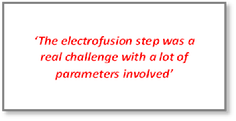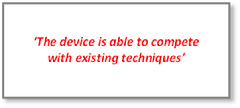 In this thesis a range of microfluidic devices is described and discussed, which finally results in an integrated chip design. Herewith high-troughput electrofusion of cells on one chip is possible which leads to the production of functional hybridomas. ‘These antibodies are required for research, diagnostics and several disease treatments,’ Rogier Schoeman says.
In this thesis a range of microfluidic devices is described and discussed, which finally results in an integrated chip design. Herewith high-troughput electrofusion of cells on one chip is possible which leads to the production of functional hybridomas. ‘These antibodies are required for research, diagnostics and several disease treatments,’ Rogier Schoeman says.
Once the single cells are encapsulated in individual droplets, two droplets, both containing different cells, are paired and electro-coalesced, to end up with a droplet containing both cells. The current device design is working well, reaching electrofusion efficiencies of 5%. Rogier Schoeman: ‘The device is able to compete with existing techniques. It is a great result, combining all these consecutive steps in one and the same device.’
The droplet platform enables single cell encapsulation, and by doing so creates the possibility to encapsulate two different cell types in one single droplet, by fusing two droplets each containing a single cell. ‘The electrofusion step was a real challenge in which a lot of parameters were involved,’ as Rogier recalls his efforts on this one.
Using electrodes perpendicular to the main channel, two different cells types encapsulated in a picoliter droplet were electro fused. Electrofusing a plasma B cell (with a short lifespan, but capable of producing antibodies), with a myeloma (a cell unable to produce antibodies, but easy to maintain in a cell culture) may result in a functional hybridoma. The hybridoma is easy to maintain in a cell culture and is still capable of producing antibodies. This method serves as an alternative to test animals, for producing these antibodies.
Combination

The final, integrated platform is a combination of several steps. It contains spiral-shaped channels and combines these with Yin-Yang shaped inlets. These are followed by a wider microchannel that contains microstructures inducing helical vortices that improve cell alignment. Once the cells are aligned, they are encapsulated with the use of the double T-junction which also enables the droplets to pair while subsequently two electrodes induce electro-coalescence.
The newly formed larger droplets - containing the two different cell types - need to be shrunken down because direct cell-cell contact is necessary to induce cell electrofusion. The droplets therefore pass six single perpendicular side channels, to reduce the droplet volume.
High speed camera

Apart from the fabrication of the chip devices and designing clever experiments to characterize the processes actually taking place, a high-speed camera was needed. Rogier: ‘Up to 3200 droplets per second are produced here,’ Rogier says ‘Working with this special microscope equipment, filming the events, took long days. I was very excited when the first results were there. First I phoned my Professor Albert van den Berg and the lab-technicians involved, to share my results.’
Articles in Lab-on-a-Chip and Electrophoresis were published. Rogier: ‘The work is not finished yet. Aligning the cells can be improved, as is the electrofusion process itself. In the months to come I want to finish some last papers to be submitted, and transfer my knowledge and experiences to successors continuing this piece of work within the Lab-on-a-Chip Group.

‘Regarding my future plans: I am not sure yet whether to continue a career in academics or switch towards industry. Working abroad for some period of time would be great.’
